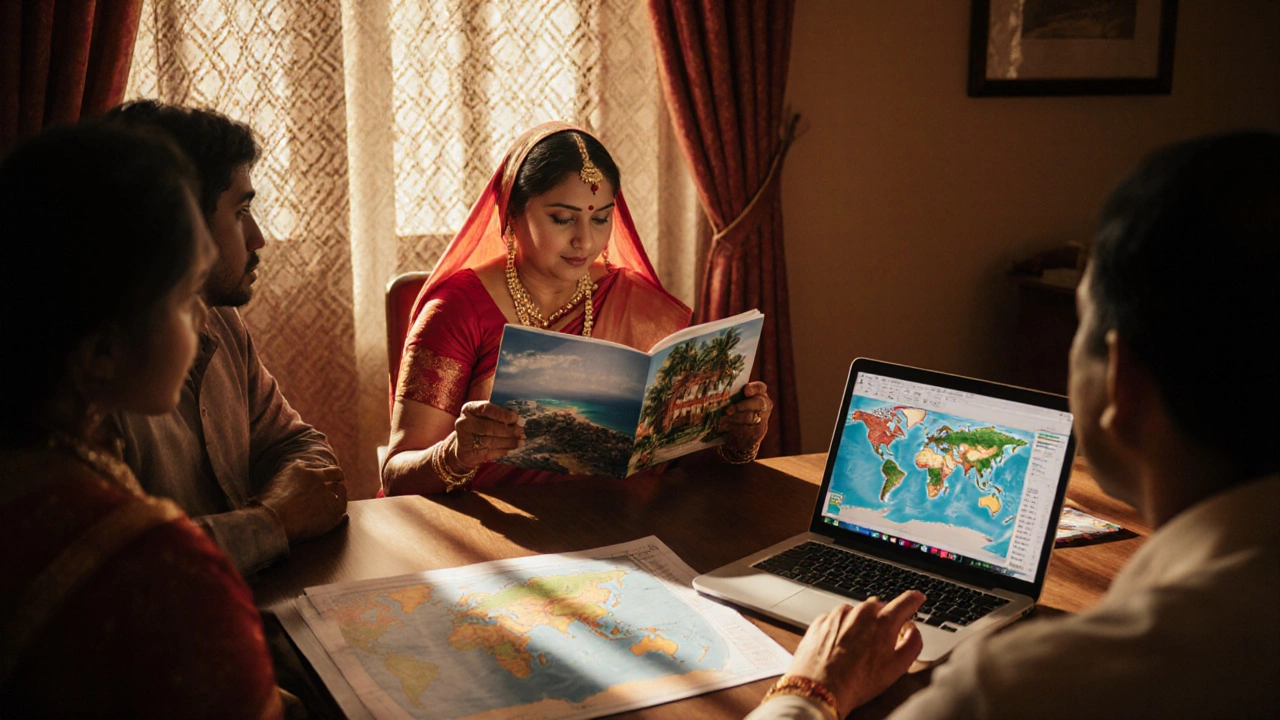When the wedding vows are spoken, the next big question often pops up: who actually plans the honeymoon planning? Across cultures, generations, and families, the answer shifts like a tide. Some couples hand the reins to the bride’s mother, others let the groom take charge, and a growing number of duos dive in together. This guide untangles the old customs, shows where modern couples are breaking the mold, and gives you a clear roadmap no matter which role lands on your plate.
Key Takeaways
- Traditionally, the bride’s family, especially the mother, has coordinated most honeymoon details in South Asian cultures.
- In Western contexts, the groom or the couple jointly handle bookings, while wedding planners often act as facilitators.
- Modern couples increasingly split tasks based on strengths: budgeting, research, or logistics.
- Hiring a travel agent or wedding planner can smooth out cultural expectations and avoid missteps.
- Use the checklist at the end to see who should do what, then adjust to fit your unique situation.
Honeymoon is the post‑wedding getaway that celebrates the start of married life. Historically it’s been a mix of romance, relaxation, and a chance for the new couple to bond away from family obligations.
Traditional Roles by Region
Culture sets the stage for who is expected to pull the strings. Below is a quick snapshot of the most common expectations.
| Region | Primary Planner | Typical Involvement |
|---|---|---|
| South Asia (India, Pakistan, Bangladesh) | Bride’s mother | Venue research, budget allocation, family coordination |
| East Asia (China, Japan, Korea) | Groom’s parents | Financial contribution, itinerary approval |
| Western Europe & USA | Couple or groom | Online research, booking, personal preferences |
| Middle East | Extended family elders | Ensuring cultural propriety, gifting |
Who Usually Takes the Lead?
Bride often enjoys a voice in destination choice because the trip is seen as her celebration after the wedding ceremony. In many Indian families, the Parents (especially the mother) handle logistics, book flights, and negotiate group rates. Their involvement stems from a sense of duty to provide a memorable start for the couple.
Conversely, the Groom may step up in cultures where the male side bears the financial burden. In the US, the groom often opens a joint account, pays the deposit, and ensures the itinerary aligns with the couple’s budget.
When a Wedding Planner is hired, they become the central coordinator, translating family wishes into a concrete plan while handling contracts, travel insurance, and on‑the‑ground logistics.
A professional Travel Agent may also act as the planner, especially for overseas trips that require visas, vaccinations, or complex itineraries.

Modern Shifts: Couples Sharing the Load
Today’s couples are more likely to split duties based on skill sets rather than tradition. One partner might excel at budgeting, while the other loves hunting for Instagram‑worthy spots.
Technology has leveled the playing field: apps like Trello or Google Sheets let both parties track expenses, deadlines, and bookings in real time. This collaborative approach often leads to a more personalized experience and reduces the chance of any single person feeling overwhelmed.
Practical Tips for Each Role
- If you’re the bride’s mother: Start the conversation early. Ask the couple about their dream destinations, dietary restrictions, and any “must‑do” activities. Draft a budget ceiling and stick to it.
- If you’re the groom: Take charge of financial transactions. Open a dedicated honeymoon fund, compare flight prices on multiple platforms, and lock in refundable rates when possible.
- If you’re the couple: Create a shared spreadsheet. List preferred dates, climate preferences, and visa requirements. Divide tasks: one researches flights, the other looks at accommodations.
- If you’re a wedding planner: Build a timeline: 12 months out - destination shortlist; 9 months - budget approval; 6 months - bookings; 3 months - travel insurance; 1 month - final itinerary.
- If you’re a travel agent: Offer package deals that include airport transfers, guided tours, and travel insurance. Highlight destinations that match the couple’s cultural and budgetary constraints.

Common Pitfalls and How to Avoid Them
Even with the best intentions, missteps happen. Here are the top three and quick fixes.
- Assuming Everyone Agrees on the Destination. Conduct a short, anonymous poll. If there’s a split, pick a midway point that satisfies both adventure and relaxation cravings.
- Overlooking Visa & Vaccination Timelines. Check official government sites at least six months ahead. Remember that some countries require proof of onward travel.
- Ignoring the Budget. Use a simple 50‑30‑20 rule: 50% for flights/accommodation, 30% for experiences, 20% for extras. Adjust if the couple opts for a luxury upgrade.
Checklist: Who Does What?
- Destination Research: Bride or bride’s mother (South Asia), groom (Western), or couple together.
- Budget Creation: Groom or joint couple account.
- Flight Booking: Travel agent or groom.
- Accommodation Selection: Couple or wedding planner.
- Visa & Immunizations: Bride’s parents (if they handle paperwork) or travel agent.
- Travel Insurance: Couple or wedding planner.
- Itinerary Finalization: All parties review and approve.
Frequently Asked Questions
Is it okay for the bride’s mother to pay for everything?
Yes, in many South Asian families the mother of the bride traditionally covers the honeymoon costs. However, it’s polite to discuss expectations early so the couple can contribute if they wish.
Should a couple hire a wedding planner just for the honeymoon?
If the destination is abroad or the itinerary is complex, a planner can save time and avoid costly mistakes. For simpler trips, a travel agent often suffices.
What if the families disagree on the location?
Facilitate a neutral conversation, list pros and cons, and consider a compromise destination that meets both cultural expectations and the couple’s desires.
How far in advance should visas be applied for a honeymoon?
Most visas require 2‑4 weeks processing, but some countries need up to 3 months. Start the application as soon as the travel dates are locked.
Can a budget‑friendly honeymoon still feel luxurious?
Absolutely. Focus on off‑season travel, boutique hotels, and local experiences. Small splurges like a sunset dinner can create a high‑end feel without breaking the bank.
